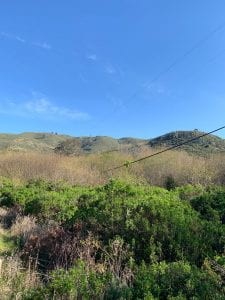Date: 02/27/20
Location: Muir Beach, 37.86131°N, -122.57529°W, sea level
Site description: Our morning excursion began at a trail along Muir Beach that eventually lead us towards the shore. The surrounding flora was extremely diverse. Small shrub and bush habitats made great spotting for species such as the Chestnut-backed Chickadee, Wrentit, and a variety of Sparrows. Tall to medium-sized pine, eucalyptus, and maple trees housed many other types of active birds such as the Black Phoebe, Downy woodpecker, and even a Red-tailed Hawk. As we travelled closer to the shoreline, several aquatic bird species such as the Brandt’s Cormorant and Great Blue Heron. This field location provided the most species recorded (28) since the start of our excursions.
Species account: Downy Woodpecker, Dryobates pubescens. Towards the beginning of the excursion, we came across a hill with several upright dead tree trunks. I noticed a small black and white bird anchored vertically to the trunk and knew immediately that it was a woodpecker species. I was assigned the Woodpecker (Piciformes) order for the bird clade parade so I was especially excited to identify this bird in the field. Downy Woodpeckers are very small in size and can be found across the majority of North America in woodland and residential areas. Their plumage is very similar to the Hairy Woodpecker’s, black and white, however the Downy Woodpecker has a shorter bill and black spots on the outer tail feathers. Most notable, is the patch of bright red on the tips of their heads. They most commonly mate and nest in tree cavities that they excavate with their strong/sturdy beaks and often live in isolation. Their diet consists of bugs and termites. These termites infest trees thus supporting a symbiotic relationship between the foraging bird and the protected tree.
Narrative: We departed the USF campus around 8:00AM on Thursday, February 27th. It was a windy, cold, and cloudy day with sparse moments sunlight. Upon arrival, I immediately noticed a huge number of active birds along the telephone poles and listened to the loud array of calls. As we followed the path, I noticed that I was listening for particular bird calls rather than solely using visually cues for recognition. Although challenging, I was able to recognize and record the a Chestnut-backed Chickadee solely based on its audible calls. The sun began to shine more prevalently as we advanced towards the shore which drew my attention towards the sky. I have noticed that I often restrict my eyesight to the plant life around me forgetting the many types of birds that soar high in the air. I was a lot more conscious this time around and found myself looking into the sky a lot more frequently. Observing a Red-tailed Hawk perched in a tree provided a completely different behavior of hawks than what I have been accustomed to observing. This being, that we have only spotted Hawk species gliding through thermals high above ground.
https://ebird.org/checklist/S65394722




